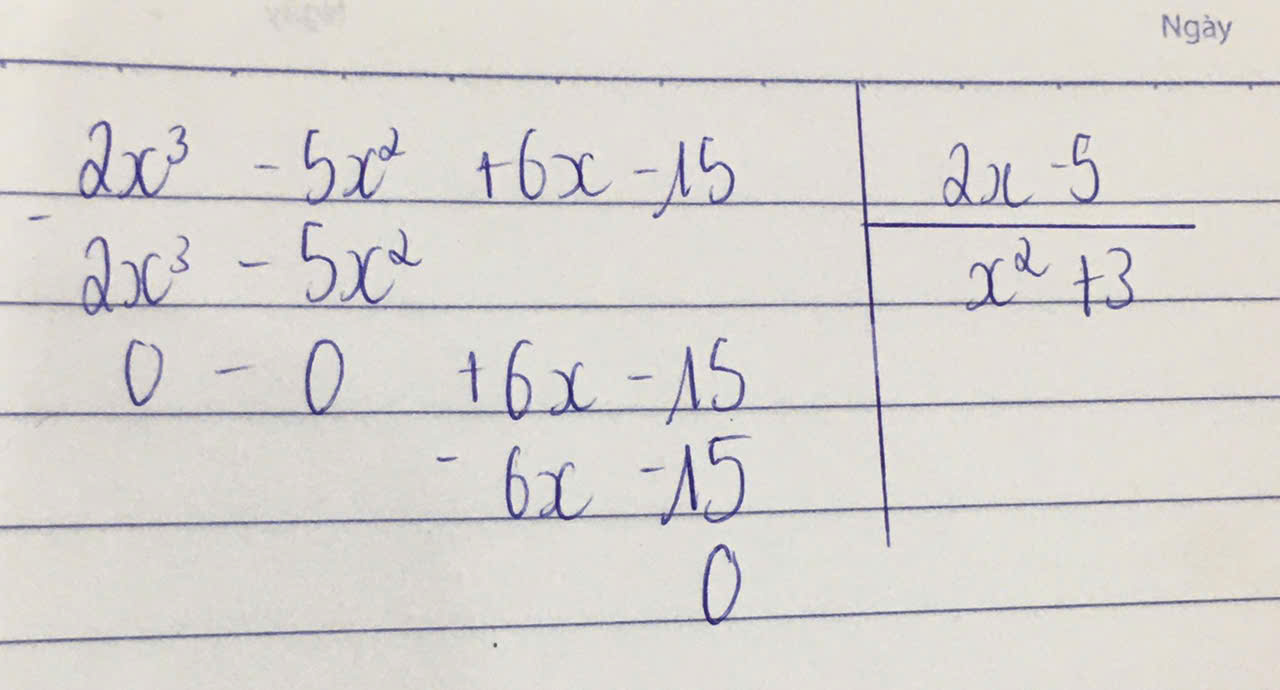Hãy nhập câu hỏi của bạn vào đây, nếu là tài khoản VIP, bạn sẽ được ưu tiên trả lời.

a,(\(6x-5x^2-15+2x^3:\left(2x-5\right)\)
\(\left(2x^3-5x^2+6x-15\right):\left(2x-5\right)\)


b)
Theo tính chất dãy tỉ số bằng nhau, ta có:
3x-1/40-5x=25-3x/5x-34=(3x-1)+(25-3x)/(40-5x)+(5x-34)=3x-1+25-3x/40-5x+5x-34= -1+25/40-34= 24/6= 4
=>3x-1=4x(40-5x)
3x-1=160-20x
3x+20x=160+1
23x=161
=> x=7

\(4)D=x^2+x+1\)
\(D=x^2+2x.\frac{1}{2}+\left(\frac{1}{2}\right)^2-\left(\frac{1}{2}\right)^2+1\)
\(D=\left(x+\frac{1}{2}\right)^2-\frac{1}{4}+1\)
\(D=\left(x+\frac{1}{2}\right)^2+\frac{3}{4}\)
Vậy biểu thức trên luôn nhận giá trị dương với mọi giá trị của x.
Các câu khác lm tương tự nhé.
Cho góp ý xíu: lần sau bn đưa từng câu một lên diễn đàn thì sẽ có câu trả lời nhanh hơn là đưa cùng một lúc như thế này đấy
hok tốt~
\(D=x^2+x+1=x^2+x+\frac{1}{4}+\frac{3}{4}=\left(x+\frac{1}{2}\right)^2+\frac{3}{4}\)
\(\left(x+\frac{1}{2}\right)^2\ge0\forall x\Rightarrow\left(x+\frac{1}{2}\right)^2+\frac{3}{4}\ge\frac{3}{4}>0\forall x\)( đpcm )
\(F=2x^2+4x+3=2\left(x^2+2x+1\right)+1=2\left(x+1\right)^2+1\)
\(2\left(x+1\right)^2\ge0\forall x\Rightarrow2\left(x+1\right)^2+1\ge1>0\forall x\)( đpcm )
\(G=3x^2-5x+3=3\left(x^2-\frac{5}{3}x+\frac{25}{36}\right)+\frac{11}{12}=3\left(x-\frac{5}{6}\right)^2+\frac{11}{12}\)
\(3\left(x-\frac{5}{6}\right)^2\ge0\forall x\Rightarrow3\left(x-\frac{5}{6}\right)^2+\frac{11}{12}\ge\frac{11}{12}>0\forall x\)( đpcm )
\(H=4x^2+4x+2=4\left(x^2+x+\frac{1}{4}\right)+1=4\left(x+\frac{1}{2}\right)^2+1\)
\(4\left(x+\frac{1}{2}\right)^2\ge0\forall x\Rightarrow4\left(x+\frac{1}{2}\right)^2+1\ge1>0\forall x\)( đpcm )
\(K=4x^2+3x+2=4\left(x^2+\frac{3}{4}x+\frac{9}{64}\right)+\frac{23}{16}=4\left(x+\frac{3}{8}\right)^2+\frac{23}{16}\)
\(4\left(x+\frac{3}{8}\right)^2\ge0\forall x\Rightarrow4\left(x+\frac{3}{8}\right)^2+\frac{23}{16}\ge\frac{23}{16}>0\forall x\)( đpcm )
\(L=2x^2+3x+4=2\left(x^2+\frac{3}{2}x+\frac{9}{16}\right)+\frac{23}{8}=2\left(x+\frac{3}{4}\right)^2+\frac{23}{8}\)
\(2\left(x+\frac{3}{4}\right)^2\ge0\forall x\Rightarrow2\left(x+\frac{3}{4}\right)^2+\frac{23}{8}\ge\frac{23}{8}>0\forall x\)( đpcm )

1: \(D=x^2+x+\dfrac{1}{4}+\dfrac{3}{4}=\left(x+\dfrac{1}{2}\right)^2+\dfrac{3}{4}>0\)
6: \(F=2\left(x^2+2x+\dfrac{3}{2}\right)=2\left(x^2+2x+1+\dfrac{1}{2}\right)\)
\(=2\left(x+1\right)^2+1>0\)
7: \(=3\left(x^2-\dfrac{5}{3}x+1\right)\)
\(=3\left(x^2-2\cdot x\cdot\dfrac{5}{6}+\dfrac{25}{36}+\dfrac{11}{36}\right)\)
\(=3\left(x-\dfrac{5}{6}\right)^2+\dfrac{11}{12}>0\)
8: \(=4x^2+4x+1+1=\left(2x+1\right)^2+1>0\)

a: \(P\left(x\right)=3x^5+x^4-2x^2+2x-1\)
\(Q\left(x\right)=-3x^5+2x^2-2x+3\)
b: \(M\left(x\right)=x^4-2\)
\(N\left(x\right)=6x^5+x^4-4X^4+4x-4\)
c: \(M\left(-\dfrac{1}{2}\right)=\dfrac{1}{16}-2=-\dfrac{31}{16}\)

Bài 1:
\(a)\)
\(B=-3xy^2.\frac{-2}{5}x^2y^3\)
\(=\frac{6}{5}.x^3y^5\)
Hệ số cao nhất: 1
Bậc của đơn thức: bậc 5
\(b)\)
Với: \(x=\left(-1\right);y=2\) ta được:
\(B=\frac{6}{5}\left(-1\right)^32^5=\frac{-192}{5}\)
Bài 2:
\(a)\)
\(A\left(x\right)=-3^2+5x+2x^4-8=2x^4-3x^2+5x-8\)
\(B\left(x\right)=-2x^4-8x+3x^2+3=-2x^4+3x^2-8x+3\)
\(b)\)
\(A\left(x\right)+B\left(x\right)=-3x-5\)
\(c)\)
\(A\left(x\right)-B\left(x\right)=4x^4-6x^2+13x-13\)

a) \(2^3:\left|x-2\right|=2\)
\(\Leftrightarrow8:\left|x-2\right|=2\)
\(\Leftrightarrow\left|x-2\right|=8:2\)
\(\Leftrightarrow\left|x-2\right|=4\)
Xét trường hợp 1: \(x-2=4\)
\(\Rightarrow x=4+2\)
\(\Rightarrow x=6\)
Xét trường hợp 2: \(x-2=-4\)
\(\Rightarrow x=-4+2\)
\(\Rightarrow x=-\left(4-2\right)\)
\(\Rightarrow x=-2\)
Vậy \(x=6\) hoặc \(x=-2\)
b)

a/ Ta có: P(x)=0
nên 4x2 - 3x=0
do đó: 4xx-3x=0
(4x-3)x=0
Suy ra: 4x-3 = 0 hoặc x=0
=> x=\(\dfrac{3}{4}\) hoặc x=0
Vậy x=\(\dfrac{3}{4}\) hoặc x=0 là nghiệm của P(x)
b/ P(x)=0
2x2-8x=0
Nên (2x-8)x=0
=> 2x-8=0 hoặc x=0
Do đó: x=4 hoặc x=0
Vậy x=4 hoặc x=0 là nghiệm của P(x)
c/ P(x)=0
7x-2x2=0
(7-2x)x=0
Nên 7-2x=0 hoặc x = 0
Do đó: x=\(\dfrac{7}{2}\) hoặc x = 0
Vậy x=\(\dfrac{7}{2}\) hoặc x = 0 là nghiệm của P(x)
d/ Ta có: P(x)=0
nên \(\dfrac{3}{4}x-\dfrac{1}{2}x^2=0\)
\(\left(\dfrac{3}{4}-\dfrac{1}{2}x\right)x=0\)
Do đó: \(\dfrac{3}{4}-\dfrac{1}{2}x=0\) hoặc x=0
Suy ra: x= \(\dfrac{3}{2}\) hoặc x=0
Vậy x= \(\dfrac{3}{2}\) hoặc x=0 là nghiệm của P(x)